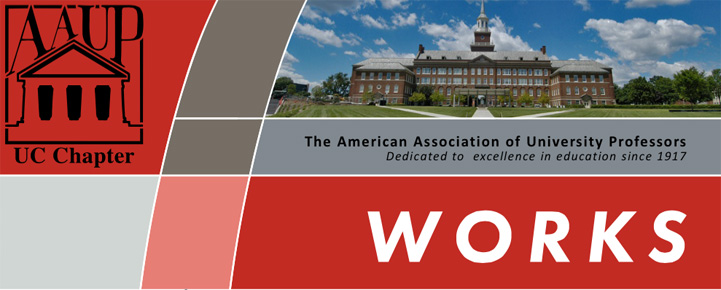- Click here to read the President’s Corner
- Click here to read Following the Money
- Click here to read PAC Update
- Click here to read AAUP Summer Institute at UC
President’s Corner
Let’s review the state of academia here at UC and in the US.
Nationally, President Trump and his advisors continue to mull over a “revised” executive order prohibiting the entry of Syrian refugees and travelers from seven other predominantly Muslim countries. This has led to fear, confusion, and uncertainty among many faculty and the over one million foreign students currently enrolled in the U.S. higher education system.
The president has also appointed a secretary of education who made millions dollars off the privatization of education and whose primary focus has been to dismantle the public education system that she now oversees.
In Iowa, there has been a bill introduced in the legislature that examines political affiliation as part of the hiring process. In a separate Iowa bill, faculty would be prohibited from bargaining over health insurance, staff cuts, and evaluations. Faculty could only bargain over wages and that would be limited to increases of 3% or the local consumer price index—whichever is lower.
In North Carolina, there has been a push to require faculty to “reflect the ideological balance of the state”. While this issue has been tabled, we’ve certainly witnessed other egregious bills passed in NC.
In Ohio, signs of trouble lurk around the General Assembly. The House has inserted language in the state budget bill that would require all public universities to review their tenure policies. Rep. Ron Young has introduced a bill that would create a state-imposed workload mandate for tenured faculty. And Rep. John Becker has once again reintroduced “Right –to-Work-for-Less,” aiming to curb unions from collecting fair share fees from non-members, even though it has been clearly established that this type of legislation is nothing more than political posturing.
Here at UC, the fight hits home. We continue to see spending on instruction reduced, reliance on adjunct faculty increase, and the harsh impacts on the core academic mission of performance based budgeting, which focuses on quantity over quality. Couple that with a ballooning athletic subsidy and a skyrocketing tuition burden for students and you have a recipe for disaster. For a deeper dive, I implore you to take a moment to read the Ohio Conference AAUP’s 2017 Ohio Education Report. In it you will find various factors that negatively affect public universities along with common sense reforms and solutions that will refocus Ohio’s education policies and procedures.
Make no mistake, these are dark times. Individually we will have no chance of successfully resisting these forces which are threatening higher education. We can and will only have an impact if we work together. The AAUP was formed in response to threats to higher education. Unfortunately, the threats we now face are far greater in scale and magnitude.
If you are a member, I encourage you to get active, get involved. If you’re not a member, join the AAUP today! Although the difference between a fair share fee and actual membership is minimal, the impact of membership is dramatic. Only together can we oppose these unfair, unwise, and unjust policies. Together we can find solutions, protect higher education, and maintain universities as a safe harbor for thought and a model for the rest of society.
Yours,
Ron Jones, President
AAUP-UC Chapter
 Following the Money: The Big Picture, Part I
Following the Money: The Big Picture, Part I
Tracking spending at UC is an unavoidably complex endeavor, given that UC is a sprawling, multifaceted institution, comprised of 13 colleges, a large library system, multiple (and expanding) administrative units and, of course, its intercollegiate athletics program. Adding to this complexity are multiple possible modes of inquiry, from the macroscopic to the granular, all of which have their merits. For information to be useful, however, it must be digestible. With that in mind, we are going to look at spending at UC in a series of focused snapshots. We will lay the foundation for this series with this first “snapshot,” an overview of spending at the colleges and the library system. In subsequent installments, we will look at spending on administration (a particularly challenging task given that administrative units are continuously reorganized), athletics, and on various categories (such as travel, distance learning, office supplies and furniture, etc.). Finally, we will examine the impact of Performance-Based Budgeting on college budgets and on spending throughout the University.
Our starting point is Fiscal Year 2008-2009 (FY09), which preceded both the dramatic, years-long rise in student enrollment at UC that began in Fall 2009, and the implementation of Performance-Based Budgeting, also in Fall 2009. As the following charts show, at most colleges, student enrollment (full-time equivalent, or FTE) rose significantly while spending failed to keep pace. Some colleges—and some Deans’ offices—fared better than others, however, which is a likely byproduct of the idiosyncrasies of Performance-Based Budgeting.
Chart I: FTEs and TOTAL EXPENDITURES, FY09-FY16, by COLLEGE, WITH LIBRARY

Chart II: TOTAL EXPENDITURES, DEANS’ OFFICES, FY09-FY16

The College of Nursing does not appear in the above chart because it presents a unique case where, beginning in FY12, spending on functions typically housed in a Dean’s Office appears to be dispersed among several different offices. This is suggested by significant fluctuations in spending attributed to the Nursing College Office ($473,168 in FY15, jumping up to $1,590,347 in FY16) and corresponding jumps in spending in other units, such as Administration (created in FY13) and the Institute for Nursing Research (where spending jumped from $250,822 in FY13 to $2,191,272 in FY14, and continued to grow from there). So, looking at spending at the College of Nursing “in reverse” may be helpful. In FY09, spending on “Academic Nursing,” where the instructional mission is apparently housed, comprised 65.3% of total expenditures at the College of Nursing. In FY16, the proportion of spending on “Academic Nursing” increased to 67.4%, a small increase but an increase nonetheless.
THREE TAKEAWAYS:
-
COLLEGE BUDGETS HAVE NOT RISEN IN PROPORTION TO INCREASES IN FTES
There is no direct percentage correlation between growth in FTEs and increases in college budgets. For example, at Arts & Sciences, FTEs rose by nearly 25% over the course of eight years, but the college budget increased by only 5.8%. In fact, among the majority of colleges where FTEs increased, only the College of Nursing’s budget growth outpaced its growth in FTEs. Among the rest, there were significant variations. At the College of Business, for example, FTEs grew by over 50%, while its expenditures grew by 38.2% from FY09 to FY16. Over the same time period, however, A&S saw a nearly 25% increase in FTEs, but only a 5.8% rise in its expenditures. At CCM, expenditures actually decreased, by 8.8%, while its FTEs grew by 6.6%.
At two colleges—Law and UC Clermont—FTEs dropped from FY09 to FY16. With respect to Law, FTEs peaked at 430 in Fall 2010; its subsequent drop corresponds with a nationwide plunge in law school enrollment over the past five years. As we have reported previously, Clermont’s FTEs similarly peaked at 2,829 in Fall 2011, and steadily dropped since then, reflecting the unique impacts of the Great Recession and recovery (with improved employment prospects among potential students). See “The More Things Change …: Instructional Spending Still Lagging, Despite Increased Enrollment,” Works, 15Dec2016.
-
DEANS’ OFFICE BUDGETS VARY WIDELY, IN DOLLAR AMOUNTS AND IN PROPORTION TO TOTAL COLLEGE BUDGETS AND FTES
When looking at Deans’ office spending, it is important to qualify Chart II by noting that, at some colleges, student financial aid comprises a significant portion of Deans’ office budgets. For example, at UC Blue Ash, student financial aid makes up approximately two-thirds of the Dean’s office budget, at the College of Business, roughly one-quarter of the Dean’s office budget goes toward student financial aid, and at the Law School, nearly one-half of the Dean’s Administration budget goes toward student financial aid. Even subtracting amounts spent on student financial aid, there were still significant differences in spending among Deans’ Offices in FY16, especially in juxtaposition with student FTEs. For example:
- College of Business Dean’s Administration: $2,843 per FTE.
- CECH College Office: $2,294 per FTE.
- UC Blue Ash: $1,215 per FTE.
- Arts & Sciences College Office: $702 per FTE.
-
SPENDING ON UNIVERSITY LIBRARIES HAS SIGNIFICANTLY DROPPED IN PROPORTION TO FTES
In Fall 2008, total UC FTEs were 29,593, and total University Library spending per FTE in FY09 was $760. By Fall 2015, UC FTEs had jumped to 34,421, but total University Library spending per FTE in FY15 dropped approximately 20%, to $600 per FTE. A reduction in Library spending seems incongruous not only with the numbers of FTEs but also with UC’s status as a Research I institution, and merits further investigation.
PERFORMANCE-BASED BUDGETING: BUDGETING DOES NOT APPEAR RELATED TO PERFORMANCE
As we have discussed in the past and will revisit in future articles, the Performance-Based Budgeting system has its own internal logic, such as it is, according to which budgets are supposed to be set in relation to a set of formulas, and the goal is a transparent distribution of resources. While the formulas are largely transparent, at least in respect to the colleges (and leaving aside administrative units), the results appear inequitable, when one steps outside the PBB box and looks at the colleges’ spending from the above perspectives. Moreover, the wide variation in spending on Deans’ offices—and the particularly high spending per FTE in some—begs the question as to whether upper Administration exercises the same oversight of it as it does of instructional spending. We’ll address that question further in future articles, when we look at operating expenditures on a granular level.
CONCLUSION
In the next “Snapshot,” we will look at spending at various administrative units across the University. As mentioned above, this is particularly challenging, given that administrative offices appear under different headings over the years. From there, we will proceed to a granular look at operating expenditures, to see where exactly the money is going. In several cases, the results may be eyebrow-raising, to say the least.
—Stephanie Spanja, J.D.
Director of Research, UC Chapter AAUP
AAUP-UC Political Action Committee Update
In the wake of recent U.S. Presidential Cabinet appointments and legislative proposals at the National and State level, we face a difficult and frightening time for faculty and for higher education in America. At the federal level, President Trump has appointed Betsy DeVos, who has a long history of not supporting public education, as Secretary of Education. He has also named evangelical leader and president of Liberty University Jerry Falwell, Jr. to lead a task force to reform higher education.
At the state level, Iowa and Missouri have introduced bills that would eliminate tenure. Iowa has also introduced a bill that would make faculty hiring decisions based on political party affiliation.
Ohio, not to be outdone, has introduced House Bill 66 (HB 66) that would create state-imposed workloads for tenured faculty. The bill specifically would require that tenured faculty teach “not less than three semester hours, or the equivalent, of undergraduate courses per semester.” Ohio has also introduced a bill that would add “commercialization” as a requirement of tenure.
Right to Work bills for private and public sector employees have also been introduced in the Ohio house. Right to work legislation would prevent unions from collecting fair share fees for non-members. It creates free-riders: employees who receive all the benefits of union membership while not contributing to its support. The purpose of Right to Work is to weaken collective bargaining and erode public employee salaries and benefits.
The news is foreboding, but not entirely dark. People are joining together with unprecedented energy to oppose these and others initiatives. Through the Chapter’s Political Action Committee (PAC), we are working with our allies on several critical responses. In conjunction with the Ohio Conference of the AAUP, the PAC is scheduling lobbying days in Columbus to meet with state representatives to discuss the blatant problems with Ohio HB 66 and other issues of import to higher education. Contact Jeff Cramerding if you are interested in participating.
The Ohio Conference has also released its 2017 Ohio Higher Education Report “Education First,” which calls for universities to re-focus on their traditional teaching and research functions. The report is being sent to lawmakers, journalists, boards of trustees, and other stakeholders.
The PAC is also hosting a Solidarity lunch with student groups and other campus unions on March 27th from noon until the food runs out on McMicken Commons. There will be a roundtable discussion on the current politics of higher education.
Faculty active in the PAC are also working to organize a Cincinnati March for Science on April 22nd, with the same platform as the National March for Science. Details will be forthcoming. Contact Julie Weast if you’d like to be involved.
Finally, AAUP-UC is currently soliciting proposals from Cincinnati-area nonprofits for a Summer Graduate Internship, with preference given to work on social and economic issues. The Internship will be expected to run from mid-May through early August, and the Chapter will provide $4,000 for an intern to engage in research or fieldwork for approximately 20 hours per week.
We must remember that our actions and our voices still matter. We can still use the power of our collective bargaining to uphold the rights and voices of our students, and to fight for quality public education. If you would like to join the PAC and help us with our mission, please contact me or Jeff Cramerding.
–Phoebe Reeves
PAC Chair
 AAUP-UC Chapter Selected to Host 2017 National AAUP Summer Institute
AAUP-UC Chapter Selected to Host 2017 National AAUP Summer Institute
Today, the National AAUP and AAUP Collective Bargaining Congress (AAUP-CBC) announced that the University of Cincinnati has been selected as the location for the 2017 Summer Institute on July 27–30. The Summer Institute is cosponsored by the AAUP and AAUP-CBC. It is the “premier training program for faculty advocates, and one of the best sources available for learning the practical skills that faculty unionists need to build their organizations and run them successfully.”
Every year, hundreds of faculty members from around the country attend Summer Institute to learn about AAUP policies, discuss the issues facing the academy, sharpen their skills as union leaders, and develop strategies for organizing.
According to Chapter President Ron Jones, “The AAUP-UC Chapter is proud that UC has been selected for the event, and it’s a recognition of the strength of the Chapter and the role we play in the AAUP in Ohio and nationally.” More information on how to register for the Summer Institute will be sent to AAUP members in the coming weeks.
–Eric Palmer, J.D.
Executive Director


